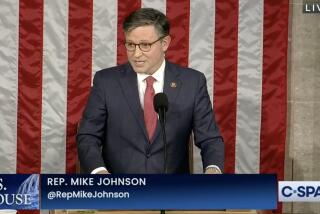Social Security, Medicare Prognosis Is Upgraded
- Share via
WASHINGTON — The financial health of Social Security and Medicare improved slightly despite the recession, trustees reported Tuesday, but they continued to urge reforms now to avoid severe benefit cuts and steep tax hikes when the baby boomers retire.
Congress, however, shows little inclination to grapple with either of the programs this election year. “The trustees’ reports don’t add any new sense of urgency,” said economist Robert D. Reischauer, president of the Urban Institute think tank. “The political and budget climates are hostile to reforms and restructuring initiatives.”
Social Security Commissioner Jo Anne Barnhart, one of six trustees of both programs, said the new numbers “suggest that we have not lost ground in the past year.”
“However,” she warned, “once the trust funds are exhausted, payroll tax revenues will be sufficient to meet only 73% of Social Security benefit obligations.”
The Social Security trust fund is now projected to be exhausted in 2041, which is three years later than in last year’s report. Medicare’s hospital insurance trust fund is projected to remain solvent until 2030, a one-year gain.
The rising output of American workers is the chief reason that the nation’s two largest social programs are holding their own in a troubled economy, said Treasury Secretary Paul H. O’Neill, also a trustee. Social Security and Medicare are supported through payroll taxes levied on workers and employers.
“It is really amazing, the 5.2% rate of productivity growth in the fourth quarter [of 2001] in the midst of an economic slowdown,” O’Neill said. Growth in productivity is not a transitory phenomenon, he said, but a long-term trend. O’Neill suggested that productivity estimates may be raised again next year.
But he quickly added: “Productivity will not solve the size of the problem one finds in Social Security and Medicare.”
Reischauer said that Social Security’s estimators were probably overly conservative in previous years in assessing productivity growth. While it is tempting to think that the economy could grow its way out of the projected insolvency of Social Security and Medicare, Reischauer said it is also highly unlikely.
“There are a lot of other uncertainties, not the least of which are the medical advances that come with the genetics revolution and could add substantially to Medicare costs--and lengthen life spans,” he said. “Social Security and Medicare costs could turn out to be larger than the actuaries are estimating.”
The crunch in both programs will start to make itself felt in a little over a decade, the trustees predicted.
In 2016, Medicare payroll tax collections will no longer be sufficient to pay for that year’s hospital benefits, projections say. The program will have to start drawing down its trust fund, a special government account that amounts to an IOU backed by the taxpayers.
Social Security will have to begin dipping into its trust fund a year later.
Health and Human Services Secretary Tommy G. Thompson said tackling reform now would help both beneficiaries and taxpayers because it would allow potentially painful changes to be made more gradually.
“I think Social Security is going to be very difficult in an election year, but I don’t think the same holds true for Medicare,” Thompson said. “I’m one of a real minority [that believes] this is an opportunity for us to do something about Medicare.”
President Bush and Democrats in Congress have offered competing proposals to add outpatient prescription drug coverage to Medicare. While Bush would also like to address the long-term solvency of the program, Democrats are more inclined to focus on improving a benefits package that in some respects dates back to the 1960s.
The number of elderly Americans is expected to double by 2030. Currently, for every Medicare beneficiary, there are four workers paying payroll taxes. By 2076, there will only be about two workers for every beneficiary.
More to Read
Inside the business of entertainment
The Wide Shot brings you news, analysis and insights on everything from streaming wars to production — and what it all means for the future.
You may occasionally receive promotional content from the Los Angeles Times.










